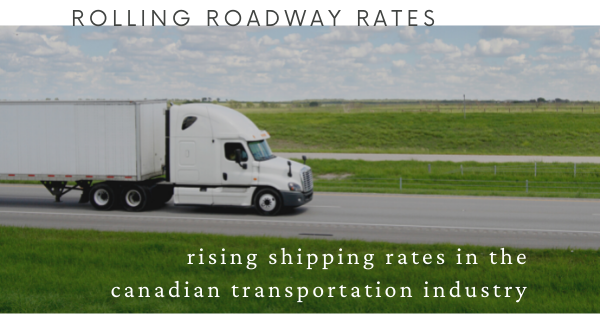By Brandon Vanden Eykel
With experience in the transportation industry for almost 15 years, my journey began in the dairy industry working at an ice cream factory before transitioning into the greenhouse industry. As the 4th generation in my family to work in the greenhouse industry, logistics and transport is my passion – helping customers become successful is satisfying knowing I have had a part in their success.
Over the last decade and a half, I’ve honed my knowledge and experience about the transportation industry from long haul to distribution. My network in the industry has also grown from developing friendships of those in the industry who own trucks, are truck drivers or own logistics companies.
The last few unprecedented months has seen the entire trucking and transport industry turned upside down. As a result of the destruction caused by the devastating floods affecting major highway routes in British Columbia in November 2021, shipping rates have almost doubled in comparison to the last five years. At its peak, freight rates had almost tripled before the busy Christmas season.
From my experience in the industry, here are my top four reasons why shipping costs have risen in the Canadian market
Diesel/Gas Prices
The cost for fuel has risen dramatically over the last year with diesel prices skyrocketing from $1.28/L in February 2021 to $1.81/L to date. A 41% increase in just one year, this equates to approximately $300 more to fill a semi-truck tank! To cover a trucking company’s costs, this increased gas price is reflected in increased trucking prices to the end consumer.

Supply and Demand
With a plethora of trucking companies in the Lower Mainland, supply has never been an issue keeping rates typically the same all year round; however, when the floods damaged the only three highway routes from the Lower Mainland to the rest of Canada, companies that routinely ship 100s of loads per week were forced to a standstill. Only now is the backlog of shipments from November almost caught up, taking trucking companies over two months to get back on track.
When Highway 3 finally opened (a last resort in comparison to the faster Highway 1 and Highway 5), it became the only major road linking the Lower Mainland with the rest of Canada. However, the route was still riddled with delays, mudslides, snow and ice on a highway that was pieced together from the undergoing construction to fix the damage. As a result, many drivers understandingly refused to drive the unsafe conditions therefore increasing the demand for more drivers.
Adding yet another challenge, was the halt on rail travel also due to mudslide and flood railway damage, meaning companies were scrambling to have those shipments driven instead. As the demand for drivers increased astronomically, so did shipping rates.
When you add the frenzied stress of ensuring priority shipments arrived on time before Christmas, large billion dollar companies had no issue paying the unreasonable transport costs. Paying the premium rate, they were able to secure their trucks while medium and small sized business struggled to keep up. Smaller companies who routinely book their trucks a year in advance lost their spot because they were unable to pay the price.
New Truck Cost and Availability
A good friend of mine who owns six semi-trucks told me last year, he bought one new truck at $195,000 and this year, is buying two new trucks at $30,000 more each – a 15% increase on an asset! This inflated cost is reflected in a rise in operating costs and eventually in increased costs to customers. However, this is if one can secure the purchase of a new truck in the first place. With computer chip shortages, parts shortages, and labour shortages due to COVID, the waiting list for a new temperature controlled 53’ trailer is booking for 2023, with no hopes to buy new for 2022.

Driver Wages
I was recently chatting with a truck driver who has been driving for almost 50 years. He was reminiscing that “back in the day,” trucking wages were almost equivalent to those in mining and oil. In the 1970s, a Canadian truck driver could earn a comfortable living with salaries of more than $100,000 in today’s standards. However, in 2018, the average annual compensation for a truck driver had plummeted to $54,158, according to Glassdoor.ca. So, the average wage of a Canadian truck driver has decreased significantly over the last 50 years.
The decline can be attributed to a supply increase of trucks and drivers, and an imbalance of the number of drivers higher than the demand for loads creating an extremely competitive market. Yet, for the responsibility truck drivers have, the challenges of their nomadic lifestyle, and our province’s high cost of living, drivers are grossly underpaid. Away from their families for days on end, driving anywhere from 10-14 hours a day and staying safe and alert at the same time, their role in our society is incredibly undervalued.
From the phone you use to the chair you sit on, everything around you involved multiple drivers and multiple trucks: transporting the raw materials to create the products, the delivery to the store for purchase, and eventually to your home. Without truck drivers, we would not have the luxuries we do today – don’t forget to thank a truck driver!
And there you have it – my two cents on why shipping and freight rates have increased for both suppliers and consumers. While we manage the fluctuation of costs, one thing that has not changed is the commitment to our customers. Providing transparency, we are continuing to ensure we provide the best experience possible as we’re only as successful as our customers are.

Brandon Vanden Eykel
Brandon is the Operations and Logistics Manager at West Coast Floral. Shipping live product to over 300 customers across Western Canada on a weekly basis, Brandon is responsible for ensuring all orders arrive in a cost effective and timely manner. With 15 years-experience in the transportation industry, his experience and emphasis on customer satisfaction has helped make West Coast Floral’s freight and shipping department an invaluable service to our suppliers and customers.

